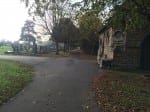Lol Hammond is a music supervisor for film based in London and working for Vertigo Films, a production and distribution company responsible for award winning films such as Bronson and Monsters. He began life as a DJ and in events, before moving into film music in 2001.
Fundamentally, Lol’s job is to commission or select and gain rights for the use of suitable music for pictures and his lecture to the audio production 3rd year covered some of the practicalities of this work, the key relationships he considers most important, and some of the intricacies and problems associated with his position.
Broadly speaking he described three categories of audio with which he has involvement –
Source Music – Previously completed music tracks, often previously released elsewhere.
Composition – Music created specifically for the picture.
Sound Design – Audio work done in post.
Hammond describes his position as a filter or intermediary between various parties and the most important relationships as those he develops with a given film director, editor and composer and to some extent the Performers Rights Society with whom he interfaces regularly to clear source music.
Discussing this use of source music, Lol explained that a lot of his time is spent securing rights to use specific tracks from their publishers and record companies. The average price at the level he works is generally £3 – £4000 per ‘side’, with a side defined as a party requiring payment from the agreement. Generally speaking, the bigger the name of the artist the larger the required fee will be with examples of Led Zeppelin and The Beatles as particularly costly. Cost for licenses is often related to the overall budget of the film, and specific use of the music within the context of the picture also effects the cost to the user – with requests for use in trailers or credits correspondingly more expensive – and fees also differ for short and small budget films as opposed to major features, with the former being more negotiable.
However, Lol pointed out that buying licenses can become complicated when dealing with source music due to variation in rights holders across different territories and that, given the long tail nature of film distribution and income, it is always advisable to negotiate rights ‘in perpetuity’ rather than for a limited period of time. Artists with a higher profile also tend to exercise more control over where their music is used, though this can also be useful if a music supervisor has an existing relationship with the artist or their management directly. He also points out that a well known piece of music can easily shift the audience focus away from the film as a whole if used.
Returning to cost, Lol also suggested that offering rights to release the movies soundtrack can sometimes be used as leverage to reduce initial costs of licensing.
Moving on to music composed specifically for a picture, Hammond refers to himself as ‘hands on’ and as drawing on a varied pool of composers as opposed to sticking with a preferred composer which is sometimes the case with other film companies. He works to guide the composer based on the directors preferences, and stressed that writing music to the picture itself is critically important when composing. Finally, he touched on a complexity of using artists-as-composers in the context of higher profile acts, which can lead to issues when making edits after the fact or requesting stem audio. On the positive side, he pointed out that specifically composed works can also be leveraged for extra revenue via publishing for the production house, citing the soundtrack for Monsters as a specific example.
Practically speaking, Lol’s work usually begins with the receipt of an assembly cut which he then watches and makes preliminary decisions as to what broad ‘type’ of songs may fit the cues before offering up three or four choices for a potential sound to the director, which he refers to as ‘temp tracks’. These choices are then refined down to a specific track or track section. A danger here is that director can easily become accustomed to the temp track and it can become difficult to substitute this for better choices.
For me, the key practical points from this lecture were that a music supervisor should always work for the film, ignoring their personal preferences, and that diplomacy and relationship management are absolutely key skills in Lol’s business.
– 731 words



